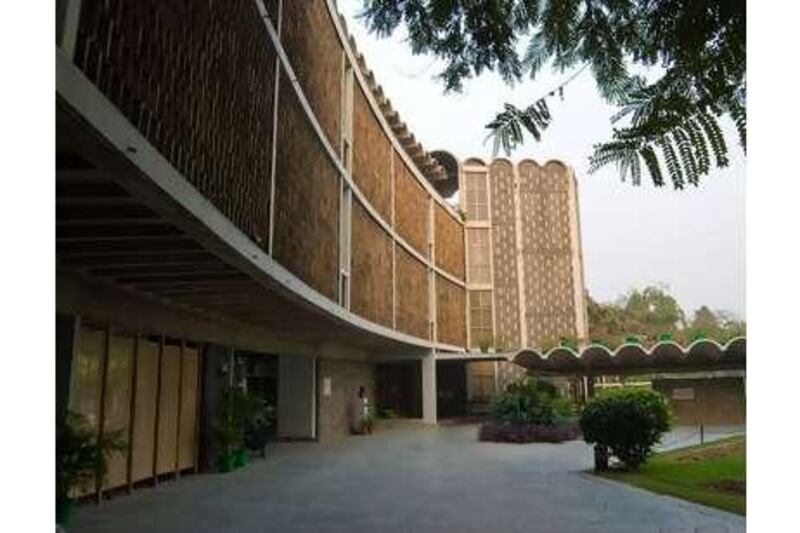NEW DELHI // The monuments of India's not-so-distant past - the practical and sometimes still operational works of British architects during the Raj - are fading fast from the country's cityscapes. Yet one major Indian artist scours the countryside almost every weekend, photographing and documenting her finds for exhibitions. As the only artist in India chasing the trail of the British Raj, Nirupma Lohtia's motive is simple necessity. "If I don't do it, who else will?" Ms Lohtia, 42, does not have to drive far from New Delhi to find a ghost or two, be it a crumbling mansion winking back at her through hollow-eyed windows, an old canal house presiding over a forgotten stretch of river or a courthouse that has long lost its jurisdiction. "They are in danger of being wiped out," she said. "People don't know them. They don't understand colonial history. People don't understand what functionality they had. They just misuse them, whereas those buildings could live forever." She knows that these once-celebrated structures, on the edge of a rapidly growing metropolis, are earmarked for anything but forever. It may be inevitable that a country so hungry for growth must devour its past. As cities expand and develop they reach deeper into the countryside, toppling old monuments. Although India's rich Mughal past - forts and mosques dating back centuries - may be protected by the Archaeological Survey of India, the more modern architecture of colonial and post-colonial India pays the heaviest price for the growth. The director general of the Archaeological Survey of India did not return calls for comment, but other officials at the government agency spoke on condition of anonymity. "I can't think of any examples of colonial architecture which is being protected by the Archaeological Survey of India," one senior officer said. "I don't know why, but I think it's because we have a cut-off date of about 100 years. And we would protect anything that is beyond that." If colonial architecture receives scant official protection from the wrecking ball of industry, post-colonial structures are afforded even less. Soon after independence in 1947, a raft of foreign architects arrived in India to modernise the country under its first prime minister, Jawaharlal Nehru. Among the most prominent was Joseph Stein, who trained in the United States before spending 50 years building steel towns, factories and government buildings across the India. The architect, who died in 2001, left his most enduring imprint on New Delhi, designing buildings for the Ford Centre, the World Wildlife Fund and Unicef. But even that legacy is gradually being chipped away. Some of Mr Stein's best-known creations, such as the American Embassy School and the Australian High Commission have since been rased. It is a trend, some suggest, that will only accelerate as the country looks to maximise its public spaces. "There is this legacy that is disappearing mindlessly," said Jeffrey Mark Chusid, a professor at Cornell University's historic preservation programme in the United States. "Way too much development happens because they can. And if the right money is in the right place, you can make a lot of money." While in India working on a research paper, Prof Chusid was dismayed by the pace of development, with shopping malls and business parks rising from the rubble of freshly rased buildings. Once considered one of the finest buildings in the capital, the India International Centre has seen several parts of it scrapped to make room for fresh renovations. "They tore down some non-profitable parts of the building," Prof Chusid said. "They quote the demand for more hotel rooms and banquet space. Basically, it's a cash cow ? that's lost the original intention of being a research and discussion centre on the highest grounds of international co-operation, understanding and debate." The Ford Foundation, another post-colonial Delhi landmark designed by Mr Stein has managed to survive, by splitting itself into two institutions and giving a section to the United Nations. "Protections in India are pretty loose anyway, given how economic development pressures and things like that seem to trump everything," Prof Chusid said. Part of the problem is that the architects of the past century may have built their structures too well. If they are still in use today, the Archaeological Survey of India typically does not extend its protection. "Because most buildings do not fall under ASI or any state department of archaeology, the protection status is not there," said the senior official at ASI. "They are still active, living buildings which are being used. They may be reused. If it was an old mansion, it may now be a school or a government department or something like that." Another problem is simply public perception: the ancient should be preserved. But what is merely old is expendable. But that attitude, said another architect at ASI, is slowly changing. "More people in all cities are becoming aware they are going to lose this architecture if they don't take care to preserve it." But it may all be for naught, Prof Chusid said, if the current building craze continues. "The Indian government is no longer in charge of constructing India. Private industry is. Hence India's development is accelerating. "Because if there isn't a clear, calm, relaxed planning model about how to do things, it becomes this incredible scramble. So you'll have 100 shopping centres built of which 60 are going to fail next year. But in the meantime, they've made incredible traffic problems, caused blackouts, taken the water supply. That's chaos." ccotroneo@thenational.ae
Monuments make way for malls
Several British colonial architectural structures in India are paying the heavy price of rapidly growning metropolis.

Editor's picks
More from the national




